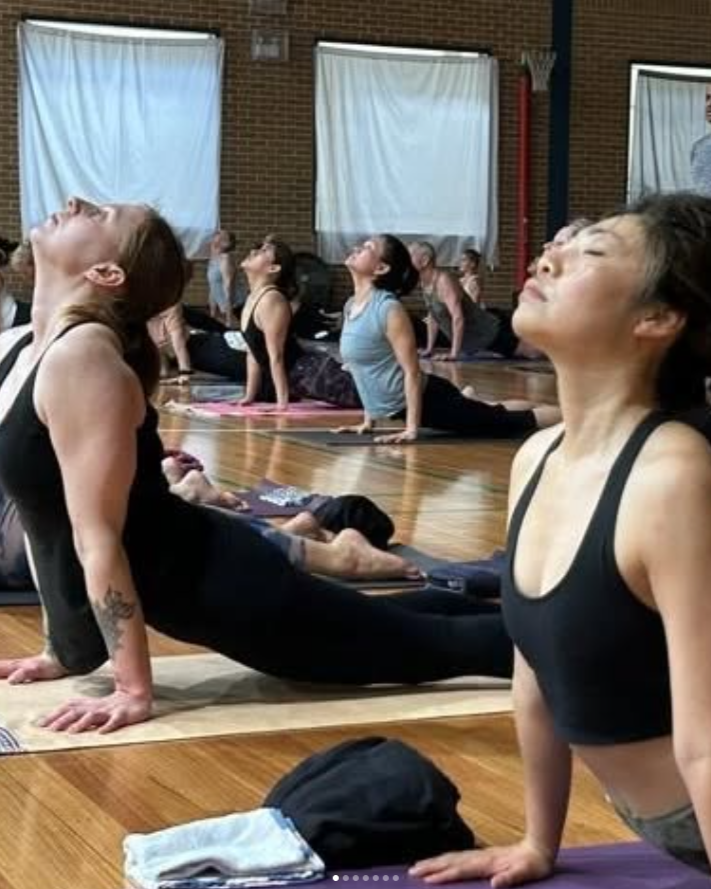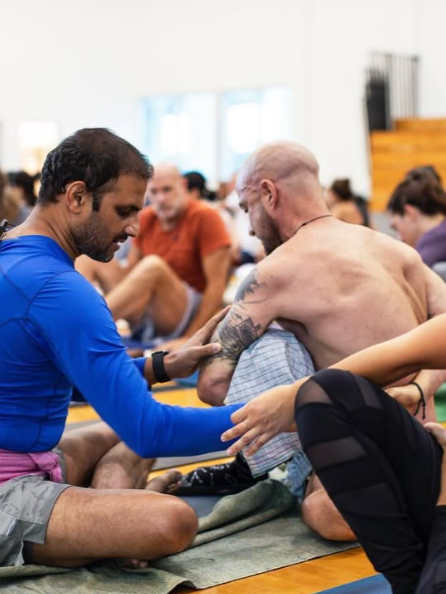Ashtanga’s Daily Repetition Cultivates Skill Beyond Thought
In the half-light of early morning, practitioners roll out their mats in the same spot they occupied yesterday, and the day before, and countless days stretching back through months and years. They move through the same sequence of postures: sūrya namaskāra A, sūrya namaskāra B, the standing poses, the seated poses. Each breath counted, each transition memorised in the body rather than the mind.
This is Mysore-style Ashtanga yoga, and its pedagogical approach offers insight into how humans actually learn complex skills.
The Ritual of Repetition in Mysore Practice
Students receive concise instruction. The teacher explains one posture at a time, one-on-one. They might adjust your alignment, or demonstrate a transition once or twice. But largely, the practice is yours. Day after day, breath after breath, the same movements. No lengthy explanations of biomechanics. No detailed analysis of which muscles should engage when. Just: do it like this, breathe like that, come back tomorrow.
This seems almost negligent by contemporary standards, where we’ve come to expect detailed breakdowns and intellectual understanding before physical engagement. Yet Ashtanga’s approach aligns remarkably well with what neuroscience tells us about skill acquisition and performance under pressure.
When you first attempt marīchyāsana or work towards jumping back to chaturāṅga, conscious attention feels necessary. You think about where your hands go, how to rotate your shoulder, which way to twist. But research on motor learning shows that well-practised skills eventually migrate from the prefrontal cortex, our centre of conscious deliberation, to procedural circuits in the basal ganglia and cerebellum.1

Conscious control and deliberative analysis are components of this style of learning, but at a point they become detrimental to execution and embedding.
The sensory-language consciousness that helps novices in the initial stages of skill development actually interferes with encoding and executing automatic circuits. It is this migration that allows a pianist’s fingers to fly across keys or a surgeon’s hands to operate with precision.
From this point of view, the Ashtanga Mysore method is ingenious. With minimal instruction and daily repetition of the same sequence – not when you feel like it, and not from an à la carte menu of competing disciplines – the practice compels migration from conscious to automatic.
The Role of Breath, Drishti, and Bandha
You don’t analyse your way into supta kūrmāsana. You breathe, repeat, fail, try again. The analytical mind gradually quietens through obsolescence. During practice, the teacher probably reminds you: “dṛṣṭi, bandha, breath.” These are kinaesthetic and interoceptive anchors for attention. The breath serves as metronome for the practice. That distinctive oceanic sound becomes both the focus of attention and the measure of whether you’re straining or forcing.
When you roll up your mat after practice, you carry with you the ability to engage with life’s demands from a place of gentle persistence beyond intellect, reverence for smooth breath and enjoyment in each moment, and positive expectation. You can achieve anything, quickly, without the friction of commentary and management.
This aligns with research showing that external focus enhances motor performance whilst internal focus on mechanics disrupts it.2 When you focus on the sound of your breath or the point where your gaze rests, your nervous system organises movement more efficiently.
Rather than think your way through the practice, you breathe through it, sensing your way, moving in a manner that bypasses language altogether. This cultivates a conceptual method of operation that doesn’t require verbal mediation.

The brain performs best when its automatic systems operate unhindered by conscious meddling. Yoga refers to this refined and non-linguistic intelligence as the subtle body.
Letting Go of Intellectual Grasping
Practitioners usually discover that the posture they’ve been working towards for months finally happens precisely when they’ve stopped grasping at it desperately. No more dissection, no more drills, no more asking everyone for tips. You just do your practice, breathe, repeat. Then one morning, perhaps when you’re tired and expecting an ordinary experience, it happens. Your hands bind, you float up, you feel something new.
The achievement often feels anti-climactic, even confusing. What changed? Nothing changed. Everything changed! The neural circuits consolidated and the pattern stabilised. Most importantly, your conscious mind got out of the way, and you can keep it out of the way.
This is the “choking” phenomenon in reverse. Anxiety causes the prefrontal cortex to micromanage automatic routines and introduces errors, whereas an optimistic and supported practice in a low pressure environment (just you and your mat, yet again, no performance expectation) allows skills to manifest. This is why techniques like mental rehearsal, breathing exercises, and pre-performance routines help athletes to switch from anxiety to automatic circuits.
Building Resilience Through Consistent Practice
Mysore practice builds this resilience through relentless consistency rather than intellectual interventions. When you practise regardless of how inspired or frustrated you’re feeling, you train your nervous system to maintain high trust in the subtle body when the ego is scattered. It is this insistence that earns our kind of yoga the descriptor haṭha, literally “forceful”.
The practice becomes a container robust enough to hold discomfort, doubt, and difficulty without collapsing into anxious selfmonitoring. Practitioners develop what sports psychologists call “pressure inoculation”, exposure to manageable stress that builds capacity to perform despite nerves.
Daily repetition delivers the ultimate gift: the capacity to show up, persist without immediate gratification, and trust in the teaching. Yes, you become stronger, physically, more flexible too, more capable and balanced. But you also develop the ability to do things without excessive commentary and to maintain equanimity when progress seems to stall.
Ashtanga Yoga Tribute Workshop – Sydney 2026
Special Dedication to Sharathji, Ashtanga Yoga & the Mysore Lineage | 24-28 March 2026
Featuring led primary, led intermediate, and Mysore style classes. With Dena Kingsberg, Mark Robberds, Olivier David sharing the week of classes with other senior teachers assisting.
The practice strips away the illusion that understanding something intellectually equates to embodying it. You can know anatomically how a pose works and still not be able to do it. Conversely, you can do poses you couldn’t explain if pressed. So much skilful living happens beyond the level of language, in the subtle body.
About the Author
Josh Pryor is CEO of Yoga Australia and a Level 3 Registered Teacher. A specialist in Mysore Style yoga, Josh’s approach is light-hearted and enthusiastic. Josh is the author of two books, including a new translation and commentary of Yoga Tārāvalī and Dṛg Dṛśya Viveka.
- Ashby, F. G., Turner, B. O., & Horvitz, J. C. (2010). Cortical and basal ganglia contributions to habit learning and automaticity. Trends in Cognitive Sciences, 14(5), 208-215. ↩︎
- Chua, L. K., Jimenez-Diaz, J., Lewthwaite, R., Kim, T., & Wulf, G. (2021). Superiority of external attentional focus for motor performance and learning: Systematic reviews and metaanalyses. Psychological Bulletin, 147(6), 618-645. ↩︎



